dYdX Review 2025: The #1 DEX for Perpetual Traders

dYdX stands out as a decentralized exchange (DEX) that operates on the Ethereum layer 2 system StarkWare, providing perpetual trading capabilities. In contrast to DEXs like Uniswap, dYdX distinguishes itself by adopting a traditional orderbook + matching model instead of relying on an automated market maker (AMM), catering to the specific demands and standards of institutional traders, while being popular among retail traders as well.
Decentralized Finance (DeFI), is without a doubt, one of the most innovative and revolutionary developments of our era. The benefits of DeFi over TradFi/CeFi are tenfold, and for the first time in history, people have a way of truly taking control of their financial health without the need for boundary over-stepping, greedy and corrupt authorities, which have proven time and time again to be untrustworthy. Are these the people we want to trust with our trading and financial activities?
Many of us live in what we consider “free” nations, so why don’t the platforms where we trade reflect our values of freedom and trustworthiness? Well, that is just one of the many things that DeFi is looking to overcome, and why I am happy to be bringing this dYdX review to you today.
dYdX TL; DR
dYdX DeFi exchange offers a great place for derivatives traders who want the benefits of a centralized trading platform in terms of features and efficiency, but the trustless, non-custodial nature of DeFi. The platform’s key focus is on perpetual and margin trading but aims to incorporate other markets and assets and become completely decentralized.
Key Features
- Decentralized trading platform that supports perpetual and margin trading as well as lending and borrowing
- No KYC
- Low fees
- Gas-Free trading
- Efficient trading interface
- Lower collateralization levels vs competitors
- Dynamic interest rates
dYdX Summary:
| Headquarters: | N/A- Decentralized Platform |
| Year Established: | 2017 |
| Regulation: | None- Decentralized |
| Tradeable Cryptocurrencies: | 36+ |
| Native Token: | DYDX Token |
| Maker/Taker Fees: | Lowest: 0% Highest:0.020%/0.050% |
| Security: | Secured by the Ethereum protocol, self-custodial security measures required Third-party audited and time-locked admin accounts |
| Beginner Friendly: | No- DeFi platforms can have a steep learning curve for new users. Those familiar with trading and decentralized applications will find dYdX straightforward. |
| KYC/AML Verification | None |
| Fiat Currency Support: | None |
| Deposit/Withdraw Methods: | Crypto |
Review: What is dYdX?
dYdX is a leading decentralized exchange created in 2017 by California-based entrepreneur and ex-Coinbase engineer Antoni Juliano under the company name dYdX Trading Inc. The DEX supports perpetual trading with up to 25x leverage, lending and borrowing. The platform runs on smart contracts on the Ethereum blockchain and leverages a layer 2 solution to provide traders with highly efficient and low gas fee trading.
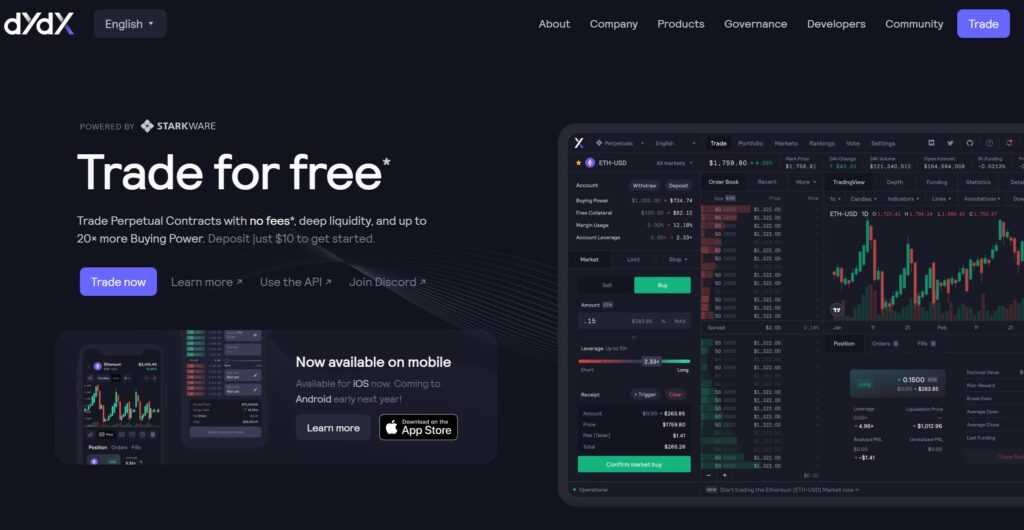
dYdX is building what they claim will be the next generation of DeFi exchanges and it is easy to see why they are able to boldly make that claim. The platform leverages StarkWare, which is one of the most advanced and powerful Ethereum Layer 2 solutions to provide traders with a lightning-fast and seamless trading experience.
It is important to note that dYdX is undergoing some pretty serious transformations and evolutions in its protocol and platform offerings. The platform has recently ceased spot trading functionality and shifted its key focus to perpetual trading, which is why that feature was the first tradable instrument made available on the StarkWare layer 2 in-house protocol upgrade.
The dYdX team states that more tradeable instruments will be made available once the platform launches the V4 upgrade, which took place in October 2023. We will cover this upgrade more in-depth later on.
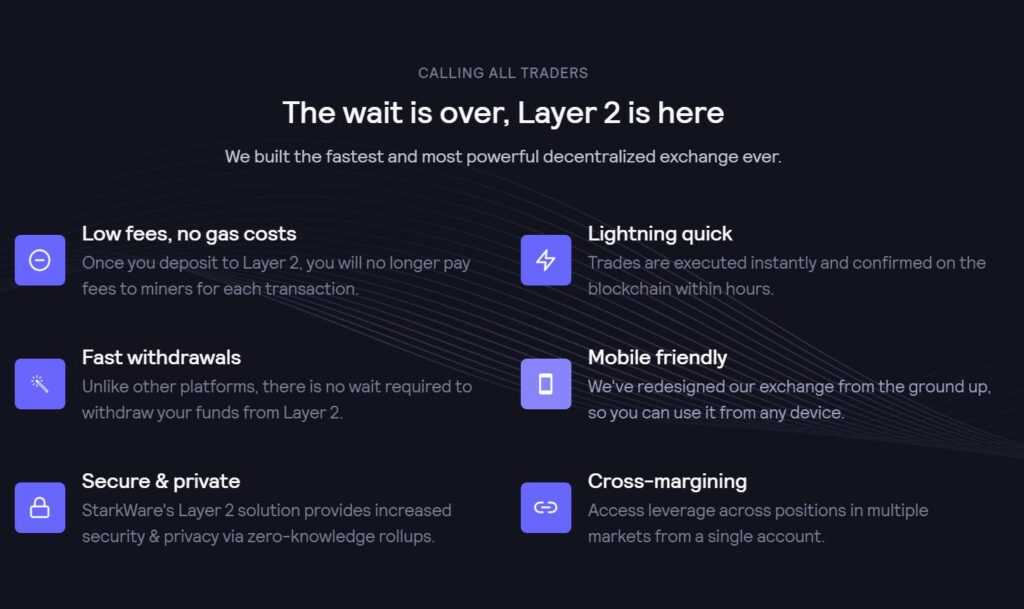
dYdX is one of the top decentralized platforms for trading perpetuals and accessing leverage. This highly ambitious platform is a real powerhouse in the DeFi industry, backed by some of the largest players in the space such as Andreessen Horowitz, a16z, Brian Armstrong of Coinbase, and more:
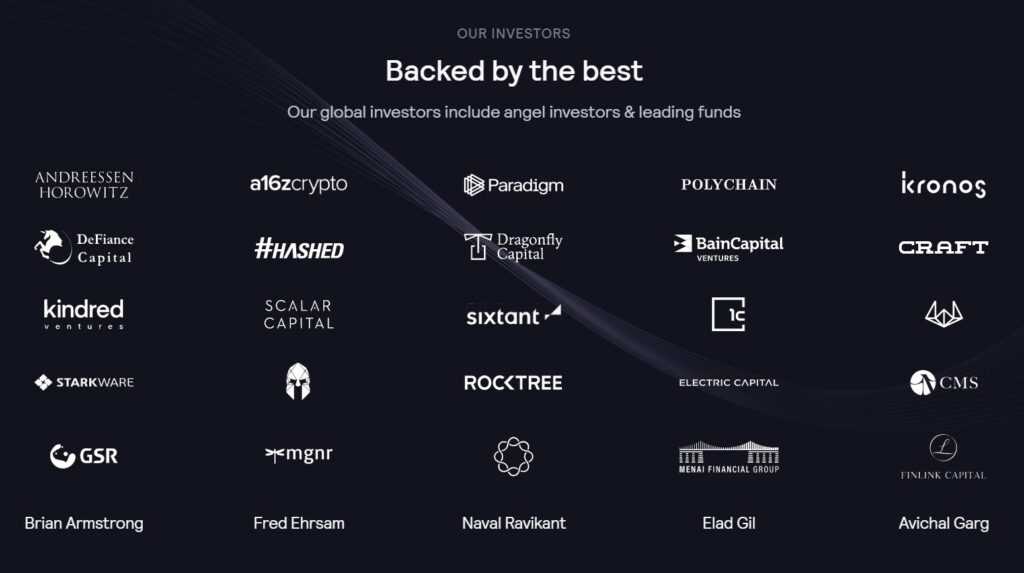
The platform is used by over 25,000 traders globally and has a healthy 24hr trading volume of over 1.2 million and a TVL just shy of $500m, making it a top 20 DeFi project in terms of TVL according to DeFi Llama, and the #2 DEX behind Uniswap according to CoinMarketCap. dYdX completed a $10m series B, and $65m series C funding round in 2021, which is helping fund the expansion and advancement of the platform.
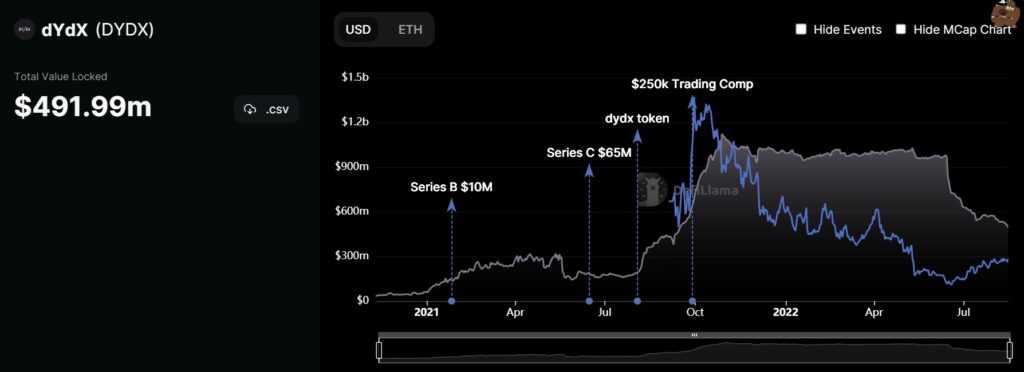
As with many DeFi financial products, dYdX is available to anyone to access and even build upon as it is open-source. User’s assets are completely managed, run, and stored by smart contract applications. The platform promises transparency and security, and they deliver on those promises. In crypto, there is a common mantra that goes, “don’t trust, verify”, and thanks to the open-source code and transparency of the team, dYdX fulfils this crypto ethos.
If you are interested in Guy's take on dYdX, feel free to check out his review of the platform below. Note that a lot has changed since he last covered the platform:
dYdX Chain
In October 2023, the dYdX Chain launched as the DEX shifted from operating as a layer-2 network on Ethereum to becoming an independent blockchain within the Cosmos ecosystem. In addition, the code is open source, an important part of the crypto ethos.
Full trading went live in November 2023. Full Trading entails several key components within the dYdX ecosystem:
- Introduction of trading rewards using dYdX's native token DYDX.
- Implementation of the 6-month Launch Incentive Program, with rewards distributed in dYdX DYDX tokens.
- Opportunity to earn staking rewards in USDC (certain denominations may be in DYDX to cover gas fees).
- Availability of full production trading for BTC-USD, ETH-USD, SOL-USD, and LINK-USD markets.
- Ongoing accrual of all protocol fees to validators and stakers, ensuring a sustained incentive structure within the system.
Chaos Labs has devised the 6-month incentive program, sanctioned by the dYdX community via dYdX governance. During the initial 6 months of full trading, early adopters of the dYdX Chain will receive a distribution of $20 million worth of DYDX tokens through this program, according to Finance Magnates.
dYdX Exchange Key Features
The protocol allows users to lend, borrow, and make bets on the future price of crypto assets through its decentralized exchange. The ultimate goal of dYdX is to bring trading instruments normally found in traditional markets such as stocks, bonds, forex, and commodities, to the blockchain and create a completely decentralized trading hub for all.
I know it may seem like DeFi protocols are a dime a dozen and there are plenty of platforms out there aiming to do the same thing; dYdX is making significant progress in becoming the future of blockchain trading for more than just crypto. Think Wallstreet meets blockchain.
Most DeFi DEXs lack the advanced margin trading tools, instruments and features that exist in the traditional market, which is why dYdX is aiming to bring decentralized trading functionality to the level of centralized trading, then by combining both, rocket the entire industry by leveraging blockchain technology to levels that do not currently exist.
Let’s take a close look at some of those features.
StarkWare Layer 2 Scalability Infrastructure
dYdX has partnered with StarkWare, a leading Ethereum layer 2 scaling solution in order to significantly increase efficiency and make gas fees nearly obsolete. At the time of writing, cross-margin perpetual contract trading is the only market available on the layer 2 protocol, but the team plans on expanding the rest of its offerings in the near future.
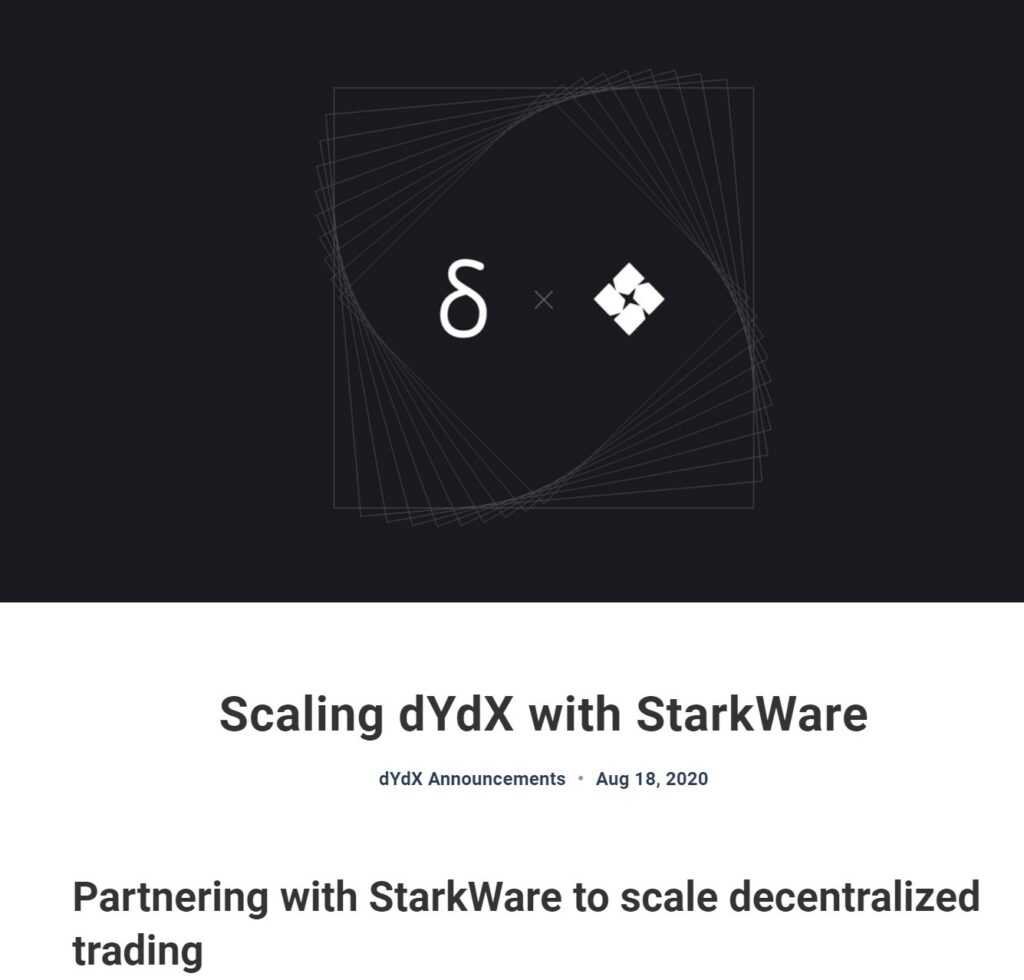
StarkWare utilizes ZK-Rollups to bundle or “rollup” transactions into a single batch, which are then posted to the Ethereum blockchain alongside a proof, attesting the validity of the bundled transactions. ZK-Rollups offer high throughput, instant finality, self-custody, and trading privacy, which makes it well suited for the dYdX exchange. Thanks to this collaboration, dYdX enjoys the following benefits:
- Significantly reduced gas & trading fees
- Reduced minimum trade sizes
- Cross-Margin capabilities
- More trading pair support
- Instant trade settlement
- Higher performing price oracles
- Higher leverage & lower liquidation penalties
This partnership and scaling upgrade marked a major advancement in the DEX trading industry and will certainly help dYdX on its mission of becoming the top decentralized trading protocol in the space.
If you would like to learn more about the difference between layer 1 and layer 2 protocols, be sure to check out our article on Understanding Layer 1 Blockchains.
dYdX V4 and the dYdX Chain
The choice for a DeFi protocol to move away from Ethereum and create its own separate chain is not something that frequently happens in the world of crypto.
dYdX chain, launched in October 2023, was built using the Cosmos SDK and Tendermint Proof-of-Stake consensus protocol. This opens dYdX to the Cosmos ecosystem, which is an interconnected system of application-specific blockchains.
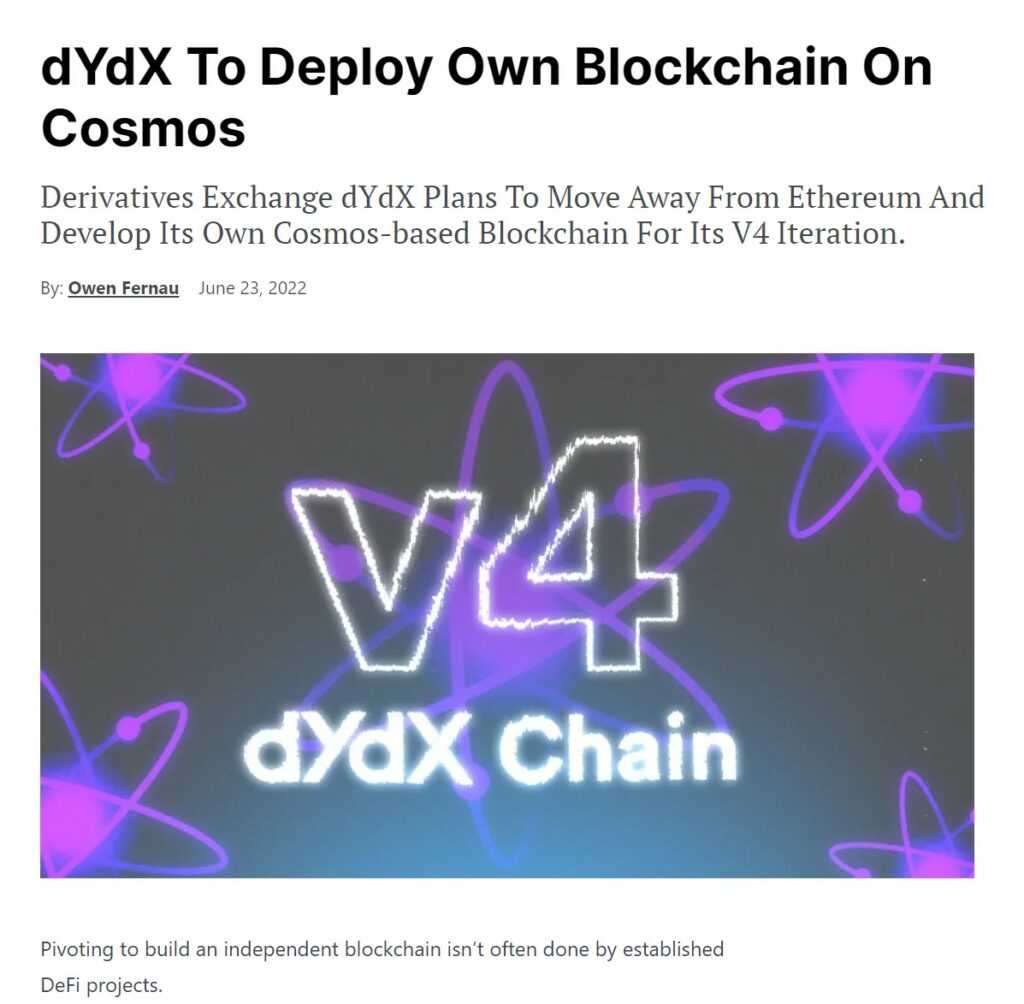
The team cited performance and centralization concerns about Ethereum L2s as the primary reason for the move, and this move will allow the protocol to be completely decentralized. Smart move among the tsunami of incoming regulatory crackdowns.
The announcement cited the DYDX token as “the most natural fit for use as the L1 token of dYdX V4.” The token will need to be staked by validators to secure the network and cover the transaction fees on the platform.
The DYDX token will be governed by its holders, with the platform company having no control over how the token is used.
The blog post had this to say:
“The main requirement for the V4 protocol is full decentralization. The decentralization of a system is equal to the decentralization of its least decentralized component. This means that every part of V4 needs to be decentralized while also remaining performant.”
In dYdX’s current iteration (V3), the platform is mostly decentralized but relies on centralized systems for the orderbook and matching engine. The upgrade to V4 and migration to Cosmos and the dYdX Chain will allow for full decentralization in all systems.
Off-Chain, Decentralized Orderbook & Matching
dYdX version 4 will feature a fully decentralized, off-chain orderbook and matching engine capable of scaling to orders of magnitude. The throughput that dYdX is looking to achieve is higher than what is possible on any currently existing L1 or L2 protocols.
This will allow dYdX V4 to have extremely high throughput and lightning-fast transactions for the orderbook, while remaining decentralized.
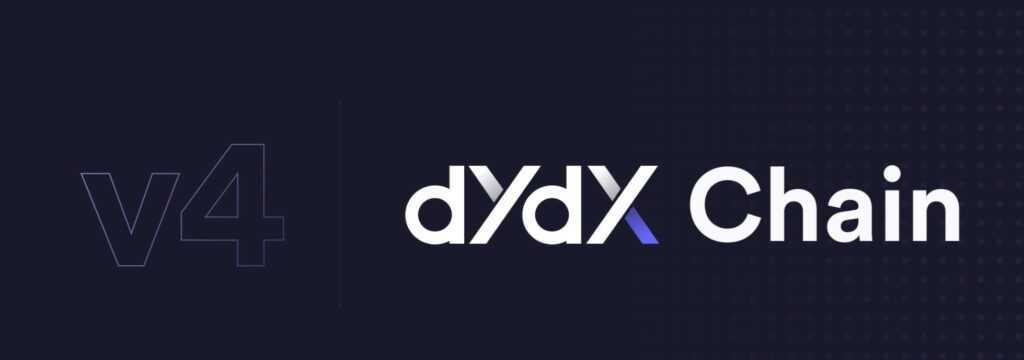
Unlike most DEXs that run an Automated Market Maker (AMM) or RFQ system, dYdX decided that an orderbook-based protocol was crucial to the trading experience that pro traders and institutions look for in a platform. The team also found that no existing off-chain orderbook systems met their criteria as there were either no matching engines or they were based on centralized matching, which led to dYdX realizing that they needed to build their own off-chain and decentralized orderbook and matching engine from the ground up.
According to the dYdX Whitepaper:
“We chose to base dYdX on the hybrid approach pioneered by 0x, as we believe it allows creation of the most efficient markets. This allows market makers to sign and transmit orders on an off-blockchain platform, with the blockchain only used for settlement.”
dYdX primarily chose to implement 0x’s infrastructure in order to improve its efficiency as a DEX, as well as use off-chain order books with on-chain settlement to increase trading performance. By building on Cosmos, there is full customizability over how the dYdX blockchain itself will work and the jobs that validators can perform.
In dYdX V4, each validator will run an in-memory orderbook that is never committed to consensus, meaning it will be off-chain. Orders placed and cancellations will be propagated through the network, which is similar to how normal blockchain transactions work. This ensures that orders placed and cancellations will always make their way through the network. The orderbook that each validator stores are eventually consistent with one another, and on a real-time basis, orders will be matched together by the network, resulting in trades being committed on-chain.
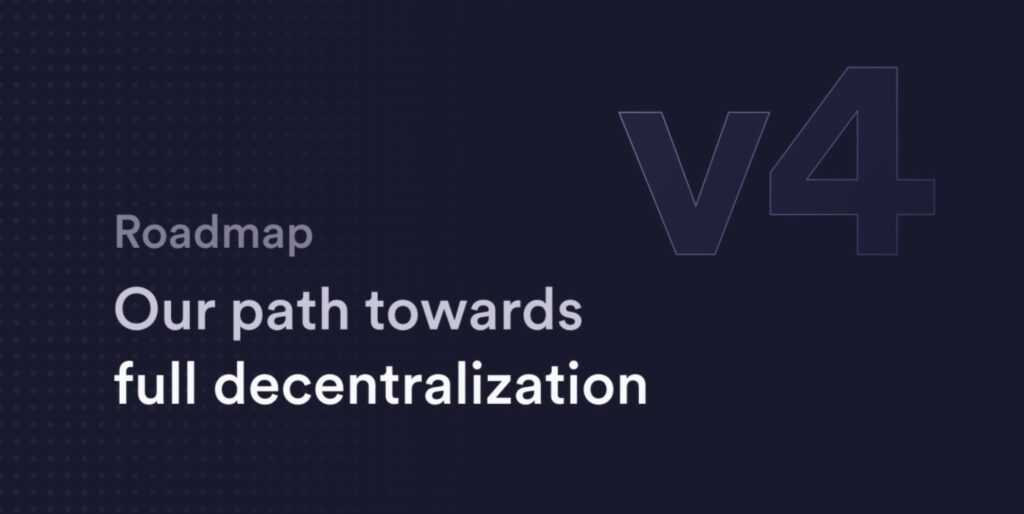
Let’s nerd out a bit and look into exactly how all this will work and be possible:
Core Node- The core node is the software that validators and node providers will run. This node is built on top of the Cosmos SDK and will run:
- Consensus
- Off-chain orderbook & matching
- All transaction types (deposit, transfer, withdraw, etc)
- Price oracles
- Other core systems
Indexer- The indexer is open-source software that powers the APIs and WebSockets, which would serve web, mobile, and programmatic traders. The indexer will take the data that exists on the core blockchain and store it in an efficient format, allowing dYdX V4 to serve performant REST and WebSocket APIs. This software is run by a distributed network, ensuring that data will always be available and decentralized.
Clients- TypeScript and possibly other language clients will conduct interaction with the network. Clients connect to both indexers and core nodes and will be used by programmatic traders as well as the website.
No Trading Gas Fees
Woohoo! Traders Rejoice 🥳
Traders on dYdX will be able to trade without gas fees. Thanks to the StarkWare upgrade, dYdX gas fees are already extremely low, but once the shift to V4 happens, a benefit of Cosmos is that traders will not need to pay gas fees to trade. Rather, they will be able to pay fees based on trading volume, similar to how fees are structured on centralized exchanges.
The fees would accrue to validators and their stakers.
If you are just hearing about the Cosmos protocol for the first time, it is a very interesting and innovative interoperability project that many are highly bullish on as they believe it could bring together and weave the future of blockchain. You can learn more about Cosmos in our Cosmos article, or alternatively, Guy also covers the project here:
Trading on dYdX
One of the biggest advantages of trading on dYdx is that it offers peer-to-peer shorting, lending, and derivatives trading on over 36 crypto assets in a high-performance environment that is decentralized. This removes the risks posed on centralized platforms such as trade manipulation, front-running, wash trading, and leveraging insider information to trade against clients.
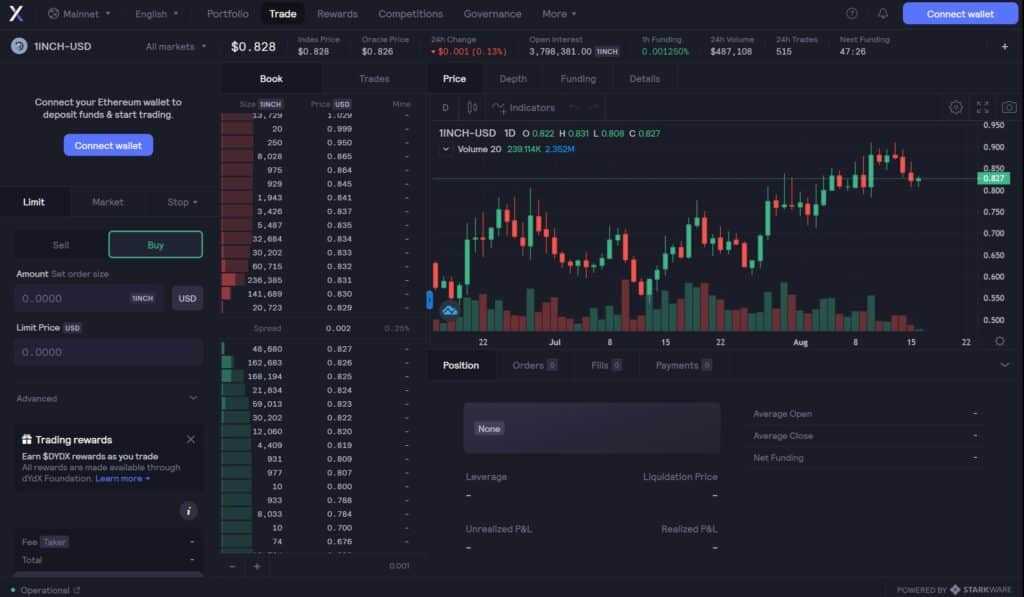
dYdX provides investors with some interesting decentralized financial strategies such as:
- Short selling- Short sells allow investors to profit on price decreases and can be used for speculation or to hedge existing positions.
- Fully-collateralised, low-risk loans for short sellers allow token holders to earn interest fees.
dYdX is the leading DEX for trading layer 2 perpetual trading contracts, NFT collections for community building, and features a Ropsten Ethereum Testnet interface for projects that want to use a risk-free testing environment.
There are very few decentralized protocols out there offering derivatives or margin trading, which is what makes dYdX massively popular among crypto traders and why they are one of the fastest-growing DEXs in terms of adoption and TVL.
dYdX Review: Margin Trading Protocol
When margin trading on dYdX, a trader borrows an asset and immediately trades it for another asset. The asset must be repaid to the lender, along with interest at a later date. Margin trading includes short sells and leveraged longs.
In a short sell, an investor borrows an asset and sells it for the quote currency. The investor makes money if the price of the asset decreases, since rebuying the asset to repay the lender costs less than the original sell price. Then, of course, the trader loses money if the price of the asset increases, since rebuying the asset to repay the lender costs more than the original sell price. The lender makes money from the interest paid by the trader.
In a leveraged long position, a trader borrows the quote currency and uses it to buy an asset. The trader makes money if the price of the asset increases, and loses money if it decreases. Gains or losses from the position are equal to the change in price of the underlying asset multiplied by the leverage ratio.
dYdX supports 3 assets for margin trading: ETH, DAI, and USDC. This is quite a limited selection of assets, but it is good to keep in mind that dYdX is a fully trustless, permissionless decentralized margin trading protocol, and not a pure lending and borrowing platform. Tradeable assets need to have adequate liquidity and volume so the limited selection of assets is quite justified as these protocols are still in their infancy and have limited users.

Users can perform two types of margin trading:
- Isolated Margin Trading
- Cross-Margin Trading
The margin trading protocol uses an Ethereum smart contract to facilitate decentralized margin trading of ERC20 tokens. Lenders can offer loans for margin trades by signing a message containing information about the loan, such as the amount, tokens involved, and interest rate.
Once received, the smart contract then sends the margin deposit from the trader’s account to itself and uses a decentralized exchange such as 0x to sell the loaned amount specified in the trader’s buy order. The smart contract will then hold onto the deposit for the loaned amount for the duration of the trader’s position.
Perpetual traders can access up to 25x leverage. Traders will need to over-collateralize their loans in order to open leveraged positions and borrow assets. On dYdX, users must deposit 125% of the loan amount before borrowing, and liquidations can occur if a 115% collateralization ratio isn’t maintained.
dYdX Review: Perpetual Trading
Perpetual trading is the flagship offering of dYdX and allows users to trade open markets with non-expirable contracts. Traders can hold their buy or sell positions indefinitely until the predetermined trade conditions are met.
For example, if a user places an order to sell 1 BTC at $100,000, the order will remain active until Bitcoin reaches $100,000 and the trade is complete. Of course, the trader can terminate the contract by closing it at any time before it is triggered.
Traders can trade contracts with up to 25x leverage and go long or short on over 35 different assets. A strength of dYdX is that traders can get started with as little as $10, which is one of the lowest minimum trade sizes in all of DeFi.
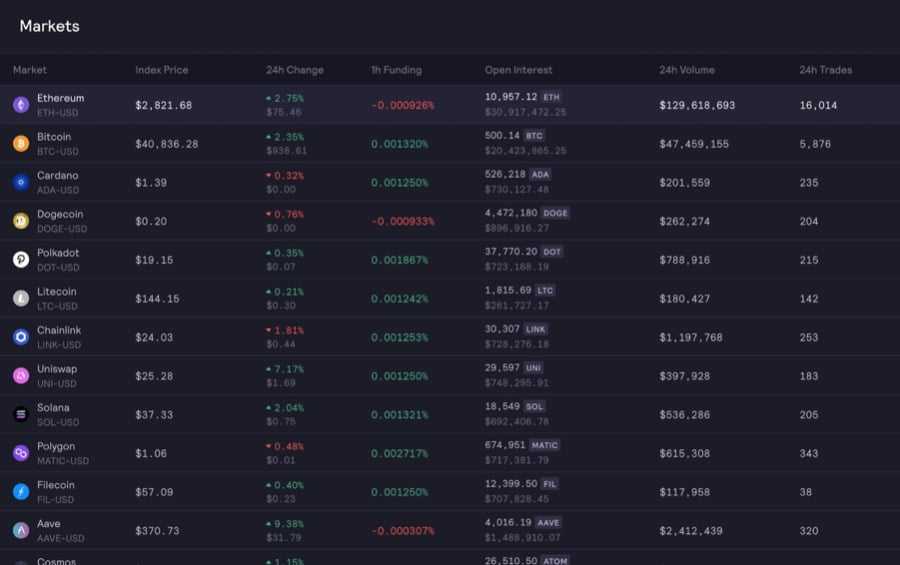
To start trading perpetuals on dYdX, users will need to:
- Deposit USDC or any ERC-20 token into their perpetual account on dYdX’s Layer-2 platform. In order to do so, users can deposit funds to their account by sending a Layer-1 Ethereum transaction through their Metamask wallet. To do this, users will be required to hold some ETH in their wallet to pay for the transaction fee.
- Generate a Stark Key- This is a public key that links a user’s Ethereum key with dYdX’s smart contracts. This Stark Key is used to identify a user’s account on dYdX’s Layer-2 infrastructure and is saved locally on the user’s browser. To generate a Stark Key and enable Layer-2 for dYdX, users will need to agree to the Terms of Use and Privacy Policies.
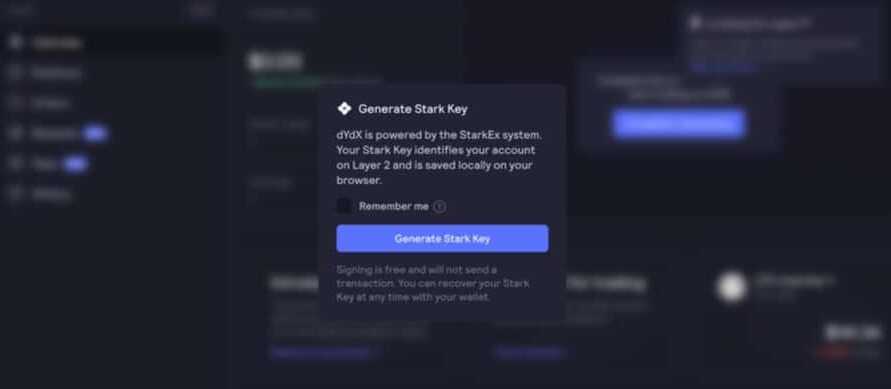
- Select a market- With cross-margining and increased scalability, dYdX can offer perpetual contracts based on more markets. Currently, the platform supports Perpetuals of BTC-USD, ETH-USD, and LINK-USD among others.
- Open position using preferred order type: Market Order, Limit Order, Stop Limit Order or Trailing Stop.
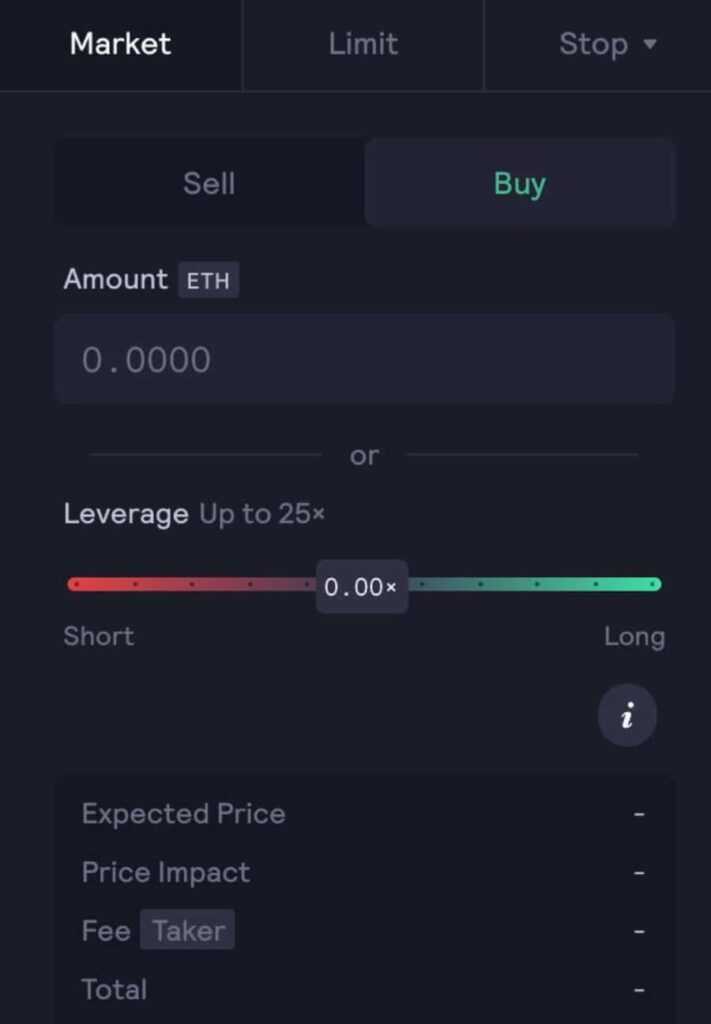 Traders Can Select Their Leverage and Preferred Order Type. Image via dYdX.Exchange
Traders Can Select Their Leverage and Preferred Order Type. Image via dYdX.Exchange
- Select Preferred Leverage Ratio. It is important to note that dYdX offers up to 25x leverage on Perpetual contracts trading. Exercising risk management is very important! This is because if you’re using 25x leverage on any asset pair, your position will be liquidated if the price suddenly moves against you by 4%. Whereas, if you’re using a modest 5x leverage, your position will be liquidated if the price moves against you by 20%, giving the trade considerably more room to run.
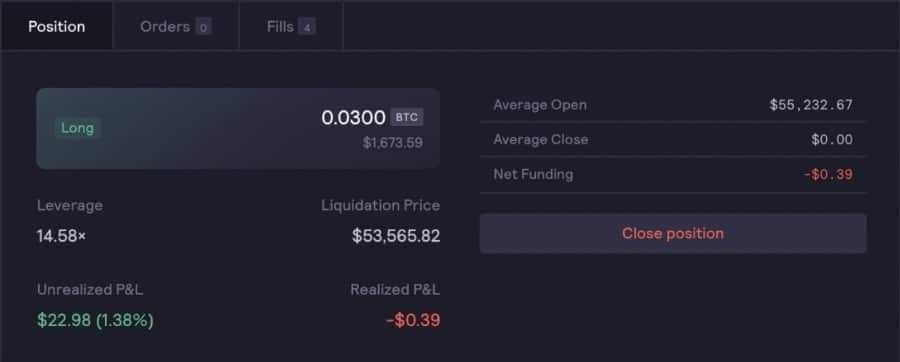
- View Open Positions in the ‘Positions’ tab to track your trades.
dYdX Spot Trading
Spot trading has been discontinued as the platform focuses on perpetual trading. There are discussions to bring spot trading back once the platform has fully rolled out version 4.
dYdX NFTs
dYdX offers an NFT collection called Hedgies, a collection of animated hedgehogs designed by two independent digital artists. dYdX’s NFT collection went live in February 2022.
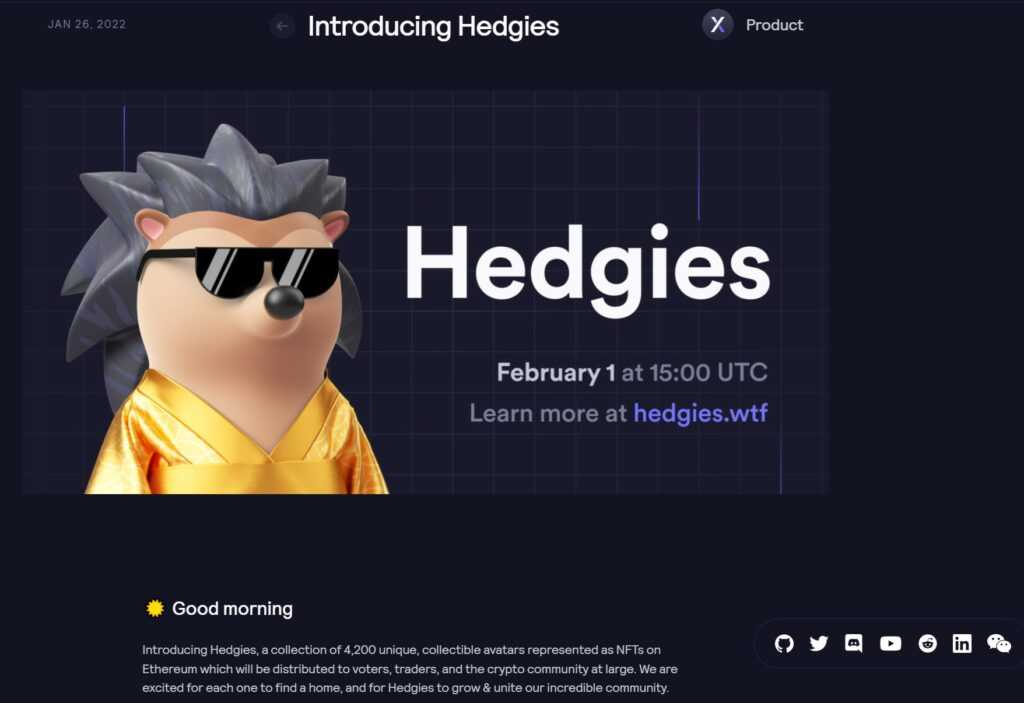
Hedgies are distributed to users based on their trading statistics and community interactions. Owners of the Hedgies NFTs are entitled to certain perks such as trading fee discounts and as a way to flex among the community. They were created to award users on various occasions and for their achievements and contributions to the community.
All hedgies in the initial distribution were free to mint and can serve as avatars for dYdX users. Hedgies have utility on dYdX and are filled with references to crypto and trading, celebrating the culture of Web3.
dYdX Review: Lending and Borrowing
Users can deposit their assets onto the platform and earn different interest rates depending on the asset. The interest rates follow a floating model, meaning that they are dynamic and updated depending on supply and demand ratios.
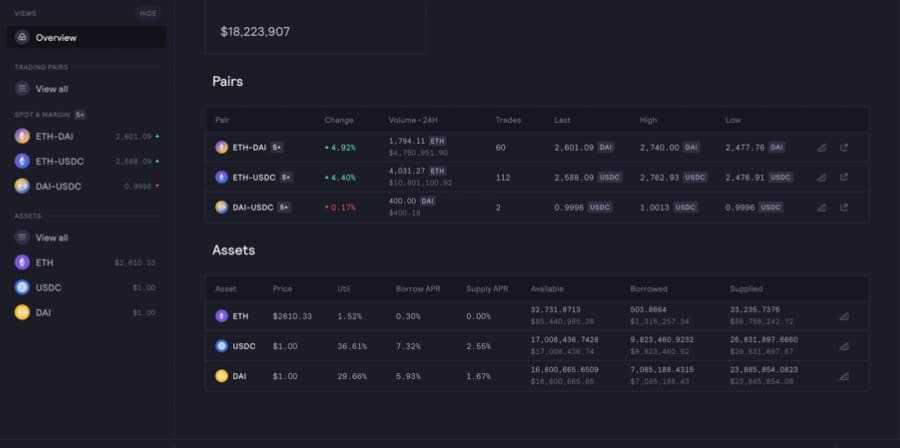
This means that rates are never locked into a specific yield percentage, interest rates move based on utilization determined by the ratio between the amount borrowed and the amount supplied, as shown in the image above.
Both lenders and borrowers interact with what are called global lending pools. There is one global lending pool per supported asset, all of which are managed by smart contracts. When lenders deposit assets into dYdX, these assets are deposited into their corresponding lending pool, allowing borrowers to gain access to those assets. This model allows for greater liquidity and enables both lenders and borrowers on dYdX to deposit and withdraw assets at any given time.
When borrowing assets through dYdX, collateralization ratio cannot exceed 125%. If a trader falls below this threshold, they will not be allowed to borrow any more assets until more collateral is provided, or some of the debts are paid. The account will be liquidated if the collateralization ratio reaches 115% and all collateral will be sold until the negative balance is 0, in addition, the account will also need to pay a 5% liquidation fee.
dYdX Governance
A year after the launch of the platform, dYdX released the DYDX governance token for the dYdX protocol.
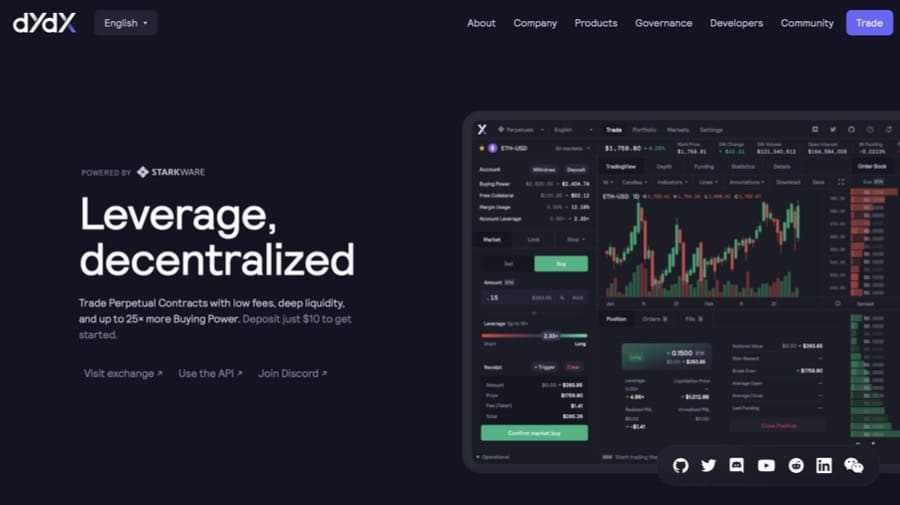
Users can earn DYDX tokens on their trading activities on the DEX with all fees paid and open interest. Users can stake their existing crypto tokens to earn yield in DYDX. The DEX offers two pools: the Liquidity Pool and the Safety Pool. Here users can stake USDC and earn rewards for contributing to the dYdX exchange liquidity.
Safety Pool- This pool creates a safety net for users who stake their DYDX tokens. The safety pool ensures that users with staked funds continue to receive a portion of the rewards in proportion to their staked tokens in the pool.
Liquidity Pool- This pool provides liquidity to the platform and encourages professional market makers to invest in the platform.
The tokens can also be used on the platform for community voting and governance initiatives. According to dYdX founder Antonio Juliano, the fundamental reason for launching the governance token was fuelled by the aspiration to eventually create a DAO-governed decentralized margin trading protocol that is completely decentralized. In an interview with The Block, Antonio stated:
“Our team has actively been researching how best to decentralise the protocol over time. Decentralisation will be a gradual process that could ultimately result in a DAO [decentralised autonomous organisation] to govern the community.”
Supported Wallets
The most common way for traders to access dYdX is through the popular MetaMask wallet or hardware wallet through a MetaMask integration.
If you are new to MetaMask and the world of DeFi, be sure to check out our MetaMask user guide.
The following wallets can be used with dYdX:
- MetaMask
- Ledger Hardware Wallets
- Trezor Hardware Wallets
- Coinbase Wallet
- TrustWallet
- Rainbow Wallet
- TokenPocket
- WalletConnect
- imToken
dYdX Mobile
The dYdX trading platform is available on IOS with plans for Android support soon. This application is great for traders who like to monitor and place trades on the go.
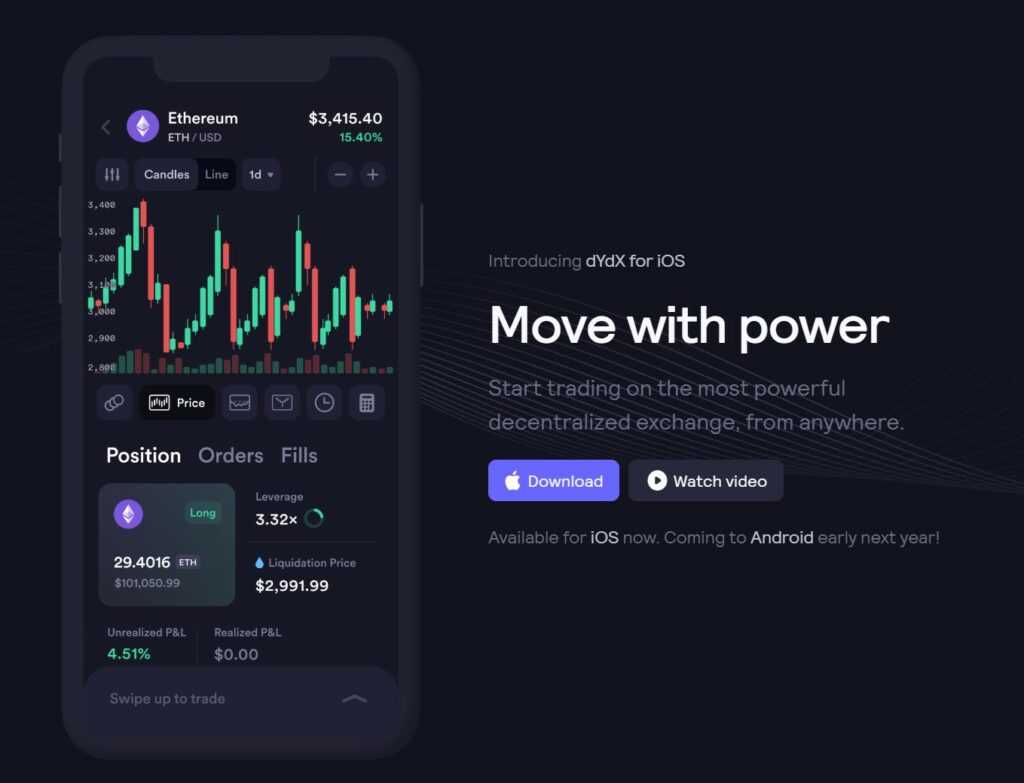
The team designed the app from scratch and did a fantastic job with the UX/UI. The app has all the functionality and features of the web platform and enjoys the same high efficiency as the web platform. Here is a look at some of the features:
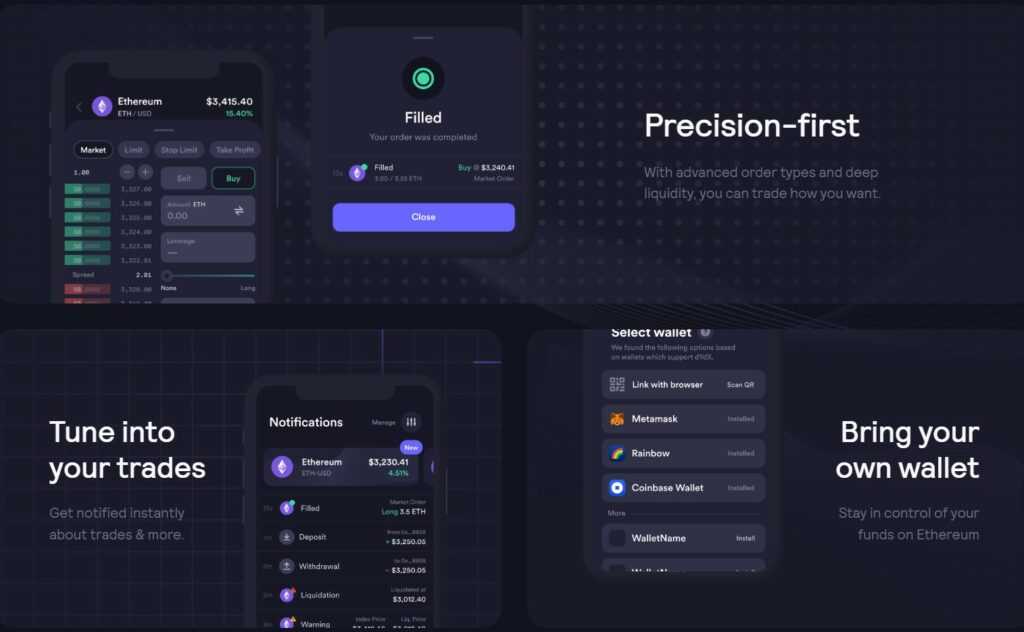
dYdX Fees
dYdX follows a tiered fee structure, similar to most centralized exchanges. The fees vary depending on if the trader is conducting margin or perpetuals trading. There are no fees for swaps between DAI, ETH, and USDC, and low gas fees when trading perpetual contracts. Gas fees will be obsolete once the merge to V4 takes place.
Perpetuals trading uses the following fee structure:
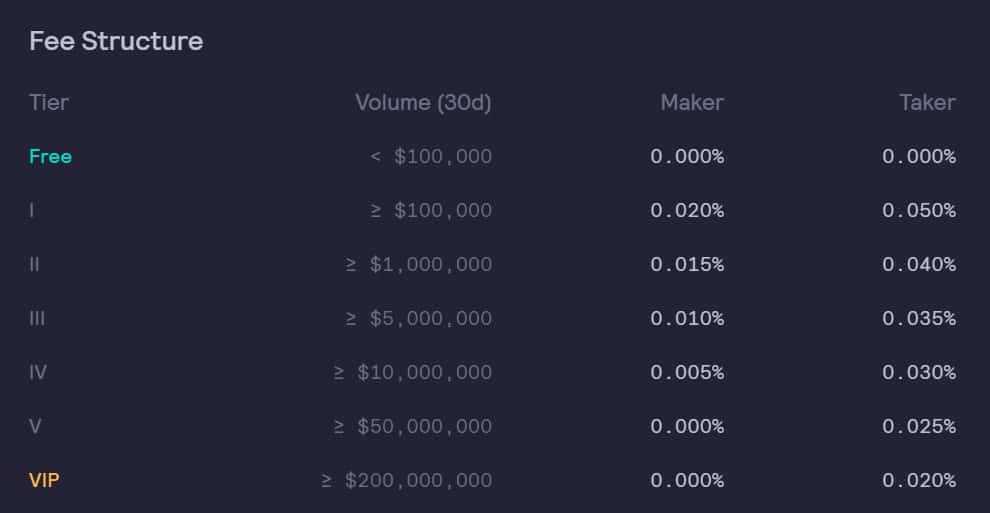
Users who hold the DYDX token can enjoy an additional trading fee discount from 3% to 50% depending on their DYDX balance.
Here is a look at the fee discount structure for DYDX holders:
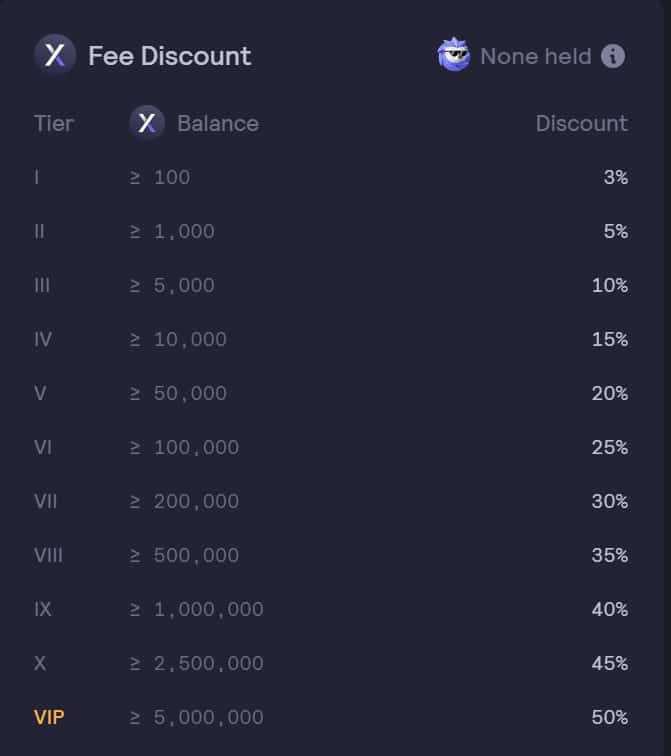
dYdX KYC and Account Verification
Because dYdX is a decentralized platform, there is no KYC or account verification necessary. Users simply need to navigate to dydx.exchange, head to the Trade section and connect their MetaMask or wallet of choice and start trading.
Pro Tip: This goes for any platform where you connect a wallet. Be sure to find the legitimate website from the source, either via a project’s whitepaper or website, and once you have the correct URL, bookmark it for future use. Many fake websites are set up that look like the original with a similar URL with the aim of draining funds from user wallets once they connect to the fake platform.
dYdX Security
It is important to note that dYdX is non-custodial, meaning that they do not hold user funds, and are not in charge of the security of the funds held in a user's wallet. The principles of self-custodial safety are at play here. Remember that crypto wallets are only as safe as the computers and phones that they are installed on, so be sure to follow crypto storage best practices.
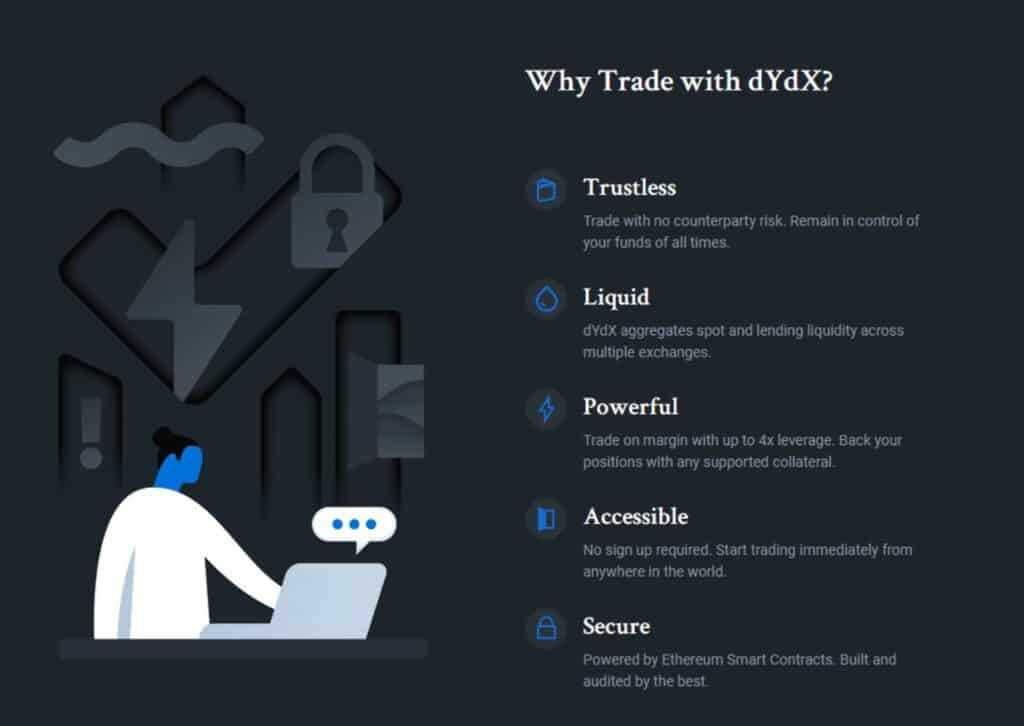
What the dYdX team is in charge of is the security of the smart contract code, the platform protocol code, and the security of the admin account. The dYdX team is committed to ensuring the security of the exchange and has conducted intensive internal testing and utilized third-party auditing firms to analyze their system and code base to ensure that there are no holes in the security. Audits conducted by these companies were made public and can be verified by anyone, the following audits have been performed:
- Perpetuals Protocol on Layer 2 Audits- Audited by Peckshield
- Perpetuals Protocol on Layer 1 Audits: Audited by Zeppelin Solutions
- Margin/Spot/Lending Protocol Audits: Audited by Zeppelin Solutions and Bramah Systems
The admin account for dYdX has a 14-day delay for layer 2 perpetuals and a 3-day delay for margin, lending, and layer 1 perpetual contracts. This means that malicious actions can be cancelled before they are carried out, and it is unlikely that any bad actors will be able to do any damage if they are able to hack into the admin account as the team would be likely to pick up the action within the time delay period and cancel it.
Since its inception, no trader has lost funds on the exchange via malicious actions and there have been no known successful hacks or issues with security.
Cryptocurrencies Available on dYdX
Lack of cryptocurrency support is one of the weaker points of dYdX, with only ETH, DAI, and USDC supported for margin trading, though there are over 36 perpetual contracts available that include most of the major altcoins which pretty impressive.
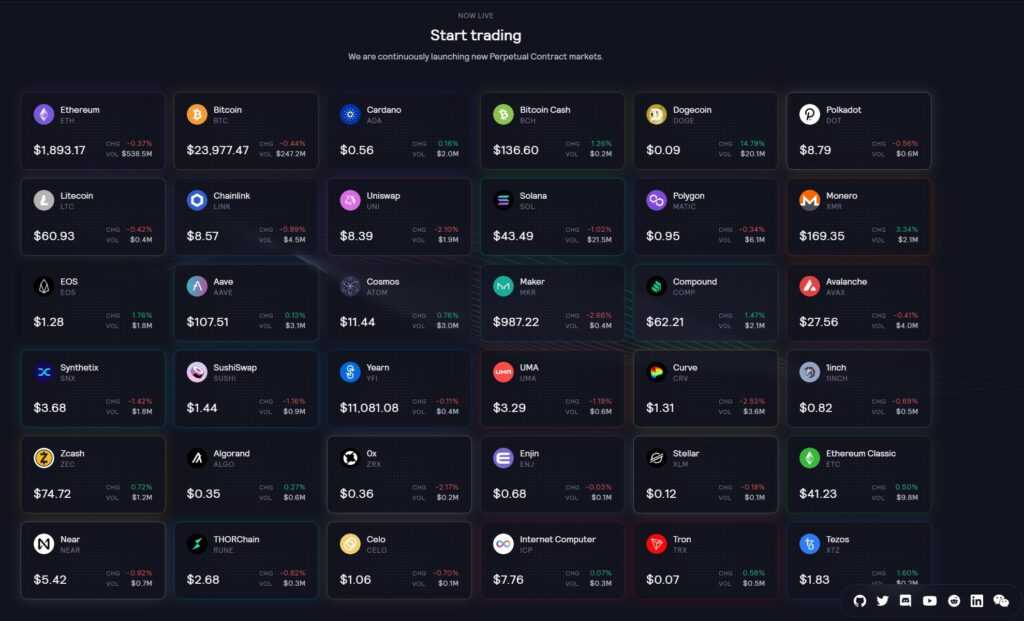
dYdX Exchange Platform Design and Usability
The dYdX platform combines the best features of centralized and decentralized exchanges and offers services such as margin and perpetuals trading, which is not common among DeFi platforms.
The dYdX protocol has been around for a long time and has proven to be successful and popular among traders, especially those interested in perpetuals trading, though V4 will witness enhancements across spot and margin trading as well, and looks to eventually support a plethora of assets outside of the crypto industry.
The exchange features a portfolio tab, which I really like, as this provides traders with an overall snapshot of their current trading situation and includes things like margin usage, free collateral, leverage, buying power, and portfolio value:
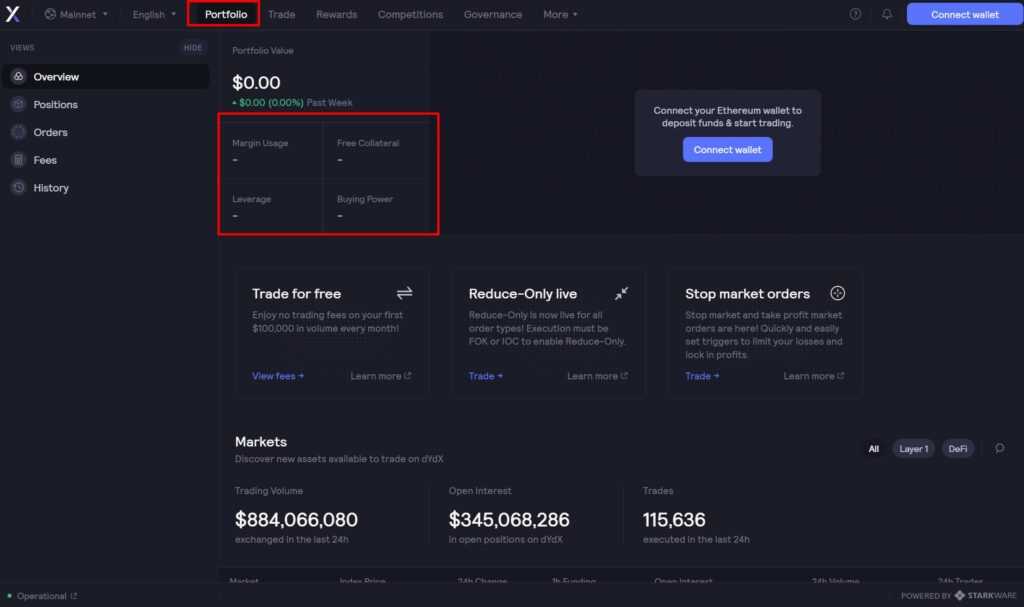
I am also happy to see that the charting screen is powered by TradingView, which has become the industry high standard for charting interfaces. Most of the major exchanges have implemented TradingView as their charting platform of choice, and it is great to see dYdX also support the interface as it ensures that dYdX is suitable for all skill levels of traders, even the most hardcore of technical analysis traders:
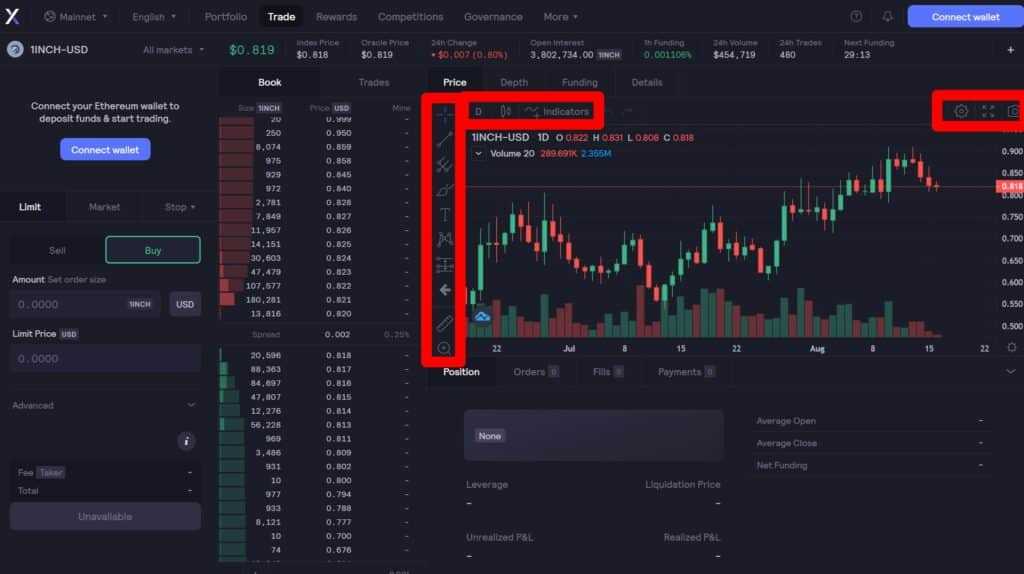
The trading screen has the following features:
Trade Sidebar- Allows users to choose the market, leverage type, trade direction, order type, and leverage.
Price Chart- Where traders can see historical price, change time frames, and conduct technical analysis.
Depth Chart- Depth chart is a visual representation of the order book that shows cumulative bids and asks and their prices.
Orderbook- Orderbook shows the current open orders on dYdX. For both the bid side and ask side, it displays size and price available. The spread between the top of the bid and ask side is displayed as well.
Positions/Balances Panel- This panel shows open position data and additional information relevant to perpetuals (such as funding and equity statistics.) This panel also has tabs that relate to limit orders and filled orders.
Traders can lend, borrow, and trade in a trustless manner on dYdX and store their profits in their own non-custodial wallets, effectively avoiding the issue of centralization, third-party risk, and single point of failure. dYdX delivers on its offerings quite flawlessly, the platform itself works as expected with lightning-fast order execution and trade fulfilment.
Using dYdX felt more akin to a centralized exchange in terms of its performance and the UI/UX, which is a benefit for most traders as it provides familiarity and seamless execution of orders. The interwovenness with a non-custodial wallet and permissionless manner makes dYdX a DeFi enthusiast’s dream.
It isn’t just myself that is impressed with the platform either, user reviews across sites like Reddit, Revain, and other exchange review sites rank dYdX quite highly with generally positive reviews.
Deposits and Withdrawals at dYdX
dYdX does not charge fees for deposits and withdrawals, however, withdrawals will be subject to the standard crypto network fees. Traders can choose to pay a 0.1% fee if they want a fast withdrawal.
There is no fiat supported on the platform, crypto withdrawals are the only method and there is no “deposit” as the platform works with the funds held in the user’s crypto wallet.
dYdX Token (DYDX): Uses and Performance
DYDX is an ERC20 governance token for the dYdX derivatives DEX that can be used in the governance process and provides holders with fee discounts.
A total of 1,000,000,000 DYDX have been minted and will be released over the span of 5 years, starting on August 3rd, 2021. The initial five-year allocation of the total supply of DYDX will be distributed as follows:
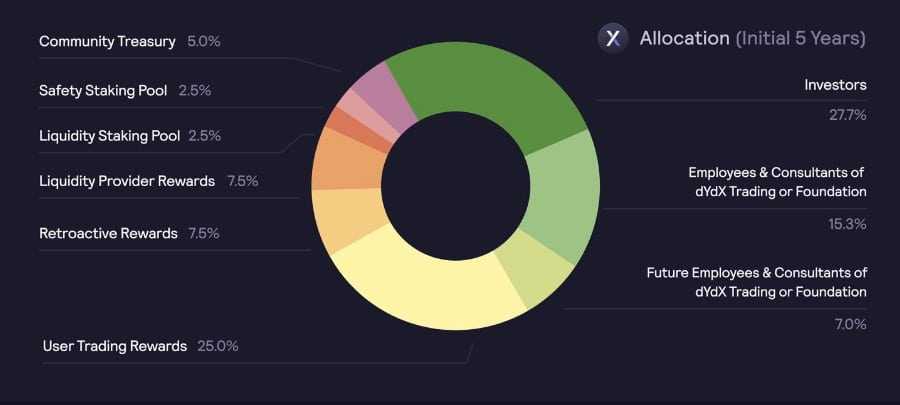
Here is a look at the 5-year token release schedule:
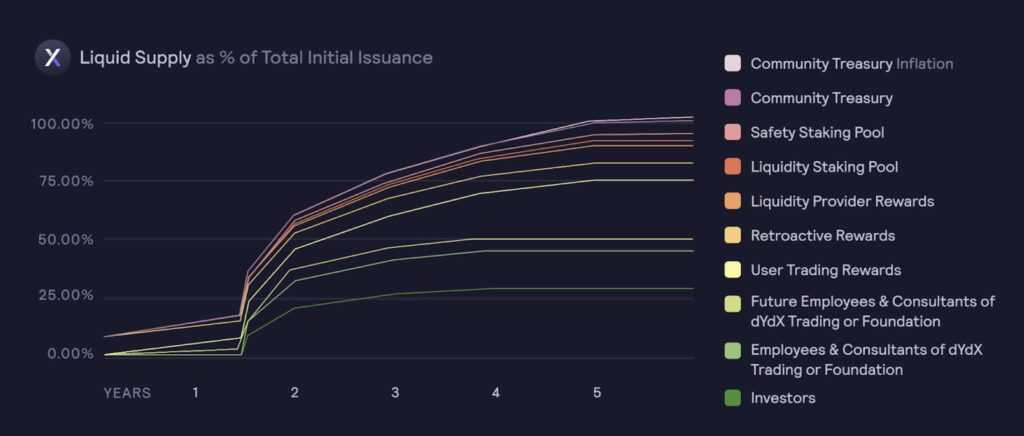
DYDX holders can enjoy the following rewards:
- Retroactive Mining Rewards- Mining rewards are distributed among dYdX users who perform trading on the dYdX Layer 2 protocol that have been using the platform for a long time. The amount of rewards depends on the trader’s overall activity and the tier to which they belong. This feature is not available for users located in the United States.
- Trading Rewards- Trading rewards are distributed to encourage crypto traders to use dYdX and used to help grow the popularity of the platform while speeding up the market liquidity process. Any trader who uses the platform is eligible to earn DYDX rewards. The amount of rewards is highly dependent on trading activity and volume.
- Liquidity Provider Rewards- Users with an active ETH address can gain liquidity provider rewards when they maintain a minimum maker volume of 5% in the previous epoch. DYDX tokens will be rewarded to liquidity providers after a period of 28 days. This reward mechanism is in place to run for five years, with the purpose of accelerating market liquidity of the platform.
- Trading Fee Discounts- As covered in the dYdX Fees section, DYDX holders can enjoy up to 50% reduction in trading fees.
dYdX Customer Support
Margin and perpetual trading can be quite tricky for new traders, the dYdX support team does their best to make this process a little easier to understand. help.dydx.exchange is a good place to find well-detailed articles that teach traders all they need to know about how to use the exchange. The dYdX YouTube channel is also a good resource to find tutorials and walk-throughs.
The platform has a well-built community forum site, full of useful documentation and community discussions. The team/community can be reached directly on Discord for traders who want to chat or have questions. Here are the links to all their socials:
- Blog - https://dydx.exchange/blog/alpha
- Discord - http://discord.gg/Tuze6tY
- Twitter - https://twitter.com/dydxprotocol
- WeChat - dYdX Protocol
- YouTube - https://www.youtube.com/c/dYdXprotocol
- LinkedIn - https://www.linkedin.com/company/dydx
- Telegram (Announcements only) - https://t.me/dydxofficial
- Reddit - https://www.reddit.com/r/dydxprotocol
- Medium - https://medium.com/dydxderivatives
To test the support, I reached out to the team on Discord and am happy to report that I received answers to my questions within seconds from the community and the admins were active in answering questions and resolving issues as well. As far as DeFi platforms go, the support on dYdX is very good.
dYdX Top Benefits Reviewed
Many DeFi users, myself included, consider dYdX to be the best DeFi protocol for trading perpetuals. The fact that traders can access leverage and trade in a trustless, permissionless manner against other traders is a great way to avoid the pitfalls and issues of using centralized trading exchanges.
The team and platform place a strong focus on transparency and security, which is of critical importance in the DeFi space. The platform and trading engine work incredibly efficiently, and the interface is designed very well. It really does feel like a professional-grade platform for traders. I really could not find fault with the platform.
What can be Improved
The biggest weakness of dYdX is the lack of supported tradeable instruments, namely, the fact that there is no spot trading. This is the biggest complaint and criticism preventing traders from using the platform and is something the team is looking to address once V4 rolls out.
Frequently Asked Questions
Most components of the dYdX platform V3 are decentralized, though the company relies on centralized systems for the orderbook and matching engine. A Full decentralization of these systems and platform is expected to be rolled out by the middle of 2023, with the introduction of dYdX V4.
dYdX has received a lot of hype as it was among the first platform to present a decentralized alternative to centralized crypto trading platforms. The protocol is highly functional and has very low fees, plus crypto holders get to benefit from self-custodied trading.
The platform executed flawlessly on its offerings of a first-rate crypto derivatives exchange with margin and perpetual options, fulfilling a niche in the market that was unmet.
Yes, as dYdX is a non-centralized trading DeFi protocol with no KYC and no account verification process, the platform can be used anonymously.
Yes. dYdX undergoes third-party security audits and utilizes time-locked admin accounts to ensure malicious actors cannot wreak havoc on the protocol. dYdX follows high-security practices, but as they are a non-custodial platform, security of funds is ultimately the responsibility of the crypto user and ensuring they practice safe crypto hygiene.
dYdX is the #1 DEX in the world by user base for perpetual trading and is widely considered to be the best DEX for perpetual traders.
Though dYdX could not be considered the best overall DEX as they do not offer spot trading, or many of the other features offered by other DEXs.
Disclaimer: These are the writer’s opinions and should not be considered investment advice. Readers should do their own research.


